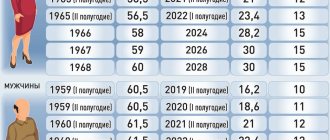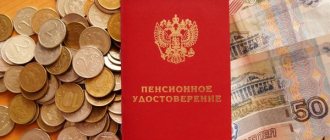The problem of the aging of the nation is relevant for Russia. Since 2010, the country has seen a decrease in the number of citizens who are of working age. According to the 2010 census, almost 19% of the country's population were citizens aged 60 years.
If the current growth rate is taken as an absolute value, then by 2030 the share of the population aged 65 alone will be almost 1/3 - 28%. And according to the UN, by 2050 the most economically active part of the population, which is between the ages of 20 and 60, will practically not exceed half of society.
OTHER USEFUL MATERIALS:
- Rating of Russian regions by life expectancy
- Comparison of pension size and retirement age in Russia and in different countries of the world
Currently, the number of pensioners in the country is growing rapidly without being replaced by an equivalent number of able-bodied citizens. Many experts believe that the only effective method to change the current situation is to increase the retirement age of working citizens, which was done in the new law on pensions
Infographics: “The number of pensioners in Russia in different years”
The retirement age will increase gradually. Increasing the retirement age, as a method to improve the situation with the aging of the nation, is used by many European countries. But, given the high standard of living in Europe, the much smaller population, the size of the territories, different from Russian ones, this measure, even if it brings benefits, will take a very long time.
An important factor aggravating the situation is that the labor market for pensioners is not developed in Russia. In addition, many employers are trying to get rid of workers of retirement age. Not realizing that they are increasing the number of unemployed qualified personnel and placing an additional burden on the working population.
Forecasts and reality about the number of pensioners
According to the latest data from the Pension Fund, in 2021 the total number of pensioners in Russia reaches 46.2 million people . Of these, the majority receive an old-age insurance pension, and another part receive a social pension. The rest are recipients of pensions for disability, loss of a breadwinner and victims of disasters.
Earlier, former head of the Pension Fund of Russia Anton Drozdov stated that due to changes in the retirement age, the number of pensioners in 2021 would decrease by 800,000 people. Let us remind you: today citizens aged 55.5 and 60.5 years will be able to retire.
Number of working and non-working pensioners in the Russian Federation
The increase in the number of non-working pensioners greatly increases the tax burden on working people. This factor undermines the well-being of existing pensioners, and an obvious indicator of this is that the pension fund budget is weakening. As a result, there is no possibility of indexation of pension benefits and it is expected to lag behind the inflation rate.
During 2015, the number of pensioners in Russia increased by more than 600,000 people.
The figure significantly exceeded the 2014 data. This is explained by the fact that from January 1, 2015, pensioners of the Republic of Crimea and a city with federal status, Sevastopol, joined Russia’s pension funds.
The number of recipients of the insurance part of pension payments under the new law during 2015 increased by almost 500,000 people and at the beginning of 2021 amounted to more than 42.7 million people. In 2021, an increase of more than half a million pensioners is expected.
In 2021, the number of pensioners increased to almost 43 million people. Thus, their share amounted to a third of the Russian population.
As of January 1, 2021, the number of working pensioners is 9.3 million . They make up 21.4 percent of their total number. In the same period in 2021, the figure was 9.6 million.
Thus, the percentage of non-working pensioners in Russia (including disabled people and those receiving survivor benefits) is slightly less than 80 percent. This is evidenced by official data, but how things really stand is known only to the pensioners themselves and their employers involved in the shadow sector.
For example, after a moratorium was imposed on the indexation of pensions for working pensioners, almost half of them ceased to be officially employed. For comparison: as of 2016, the number of working pensioners was 15.2 million people, and a year later, in 2017, it was 9.8 million.
Number of pensioners in some regions in 2021:
- Most pensioners live in the capital - 2,669,966;
- Moscow region - 1,878,776;
- Krasnodar region - 1 469166;
- Novosibirsk - 800 100;
- Rostov-on-Don - 1,100,000;
- Kazan - 1,106,900.
These figures do not include the number of military retirees, since their retirement is carried out by the military department. The category of military pensioners of the Ministry of Defense includes military personnel who have 20 or more years of experience in the Armed Forces, disabled people from military service and those who receive a military pension for the loss of a breadwinner.
The number of military pensioners in 2021 exceeded the regular composition of the modern Armed Forces. It is difficult to talk about the exact ratio of retirees and active military personnel, because there is a constant movement of personnel in the army: conscription, retirement, and the annual arrival of new personnel from military schools.
According to today's statistics, the supply of fresh personnel is stable or more than in previous years. But those who apply for pension benefits are approximately 1.5 times less than military pensioners. The growth in the number of pensioners in the army is much lower than in the civilian world, but, nevertheless, it is present.
According to forecasts, by 2030 the growth in the number of military pensioners should stabilize and stop at 700,000 people, which should account for 1/3 of the active military in the Armed Forces.
It is planned that stabilization will be facilitated by the increased attention of the state to increasing the amount of pay for military personnel, which will attract more young people to the ranks of the Russian army, the Ministry of Internal Affairs, the Ministry of Emergency Situations and other law enforcement agencies.
As for the situation with the population of retirement age, by 2021 the labor market is expected to suffer from the fact that the birth rate fell sharply in the 90s, that is, a decrease in the number of working-age population in Russia by 10%. It is also predicted that the number of 80-year-old citizens will double and a significant increase in pensioners born in 1960–1965.
Dynamics of the number of pensioners from 2012 to the present
| Year | Total number of pensioners, million people. | Receiving old-age insurance pensions, million people. | Receiving social pensions, million people |
| 2012 | 40.2 | 32.9 | 2.8 |
| 2013 | 42.8 | 33.4 | 2.9 |
| 2014 | 43.3 | 33.9 | 2.9 |
| 2015 | 43.8 | 34.4 | 3 |
| 2016 | 45.2 | 35.5 | 3.1 |
| 2017 | 45.7 | 36 | 3.1 |
| 2018 | 46.1 | 36.3 | 3.1 |
| 2019 | 46.5 | 36.7 | 3.2 |
| 2020 | 46.2 | 36.3 | 3.2 |
Detailed number of pensioners in Russia in 2015-2016.
| 2015 | 2016 | |
| Number of pensioners registered with the Pension Fund | 41456000 | 42 729 00 |
| Including: | ||
| By old age | 34422000 | 35555000 |
| Disabilities | 2317000 | 2267000 |
| Survivor loss | 1331000 | 1395000 |
| Victims of radiation disasters | 312000 | 332000 |
| Civil servants | 66000 | 71000 |
| Social | 3007000 | 3108000 |
| Working pensioners | 14917000 | 15259000 |
| Including: | ||
| By old age | 13872000 | 14199000 |
| Disabled people | 773000 | 759000 |
| Survivor loss | 17000 | 23000 |
| Victims of radiation disasters | 118000 | 127000 |
| Civil servants | 20000 | 22000 |
| Social | 116000 | 128000 |
What is the essence of the reform?
Due to the growing number of pensioners, increasing life expectancy, and a decreasing share of the working-age population, the burden on the country's pension system began to grow at a monstrous pace.
Western economists, offering a way out of the current situation, at various meetings with Russian officials, repeatedly recommended raising the retirement age, which was quite low compared to world standards.
When it was no longer possible to delay, the reform was set in motion. By 2028, the retirement age for men is expected to be 65. For women it will be around 60 years of age. Before the reform, men and women retired 5 years earlier.
The period until 2028 was declared transitional. Every year, the country's men and women of retirement age will become eligible for pensions later and later. For example, according to expert calculations, in 2021, 800 thousand Russians will postpone their retirement, taking into account those whose right to pension was postponed in 2021.
How many WWII veterans are alive in Russia?
As of January 1, 2021, there are 134,735 registered Great Patriotic War Veterans in Russia who receive monthly cash payments.
These include participants of the Second World War, including:
- persons who did not serve in military service outside the active army (58,777);
- persons who served in military service outside the active army (1992);
- persons awarded the badge “Resident of besieged Leningrad” (73888);
- persons working at defensive facilities and crew members of transport fleet vessels (78).
The table below shows how the number of participants in the Great Patriotic War has changed since 2013:
| Year | Total number of WWII veterans, people. |
| 2013 | 245014 |
| 2014 | 226366 |
| 2015 | 210366 |
| 2016 | 194767 |
| 2017 | 178817 |
| 2018 | 163510 |
| 2019 | 149280 |
| 2020 | 134735 |
The largest number of WWII veterans live in the United States of America - almost 430 thousand people.
How many older people die each year?
In Russia, mortality is 13.8% of the total number of citizens. Moreover, 65% of the total number of deaths were citizens of retirement age.
The mortality rate among the male part of the population is higher than among the female part!
Every year in Russia the number of citizens of retirement age increases. Consequently, the burden increases both on able-bodied citizens and on the state as a whole. Therefore, authorities are seeking to modernize the pension system to reduce costs.
Number of pensioners in Moscow and constituent entities of the Russian Federation
According to statistics provided by Rosstat, 32.3 million pensioners live in cities, and another 11.2 million live in rural areas.
There are 3.2 million pensioners living in Moscow, of which 2.7 million receive old-age pensions, 139 thousand receive social pensions. There are 2.1 million registered pensioners in the Moscow region. 1.8 million of them receive an old-age pension, and 101 thousand people receive a social pension.
The table below shows the number of pensioners in the Federal Districts.
| Name of the federal district | Total number of pensioners, million people. |
| Central Federal District | 11.5 |
| Northwestern Federal District | 4.2 |
| Southern Federal District | 4.8 |
| North Caucasus Federal District | 2.5 |
| Volga Federal District | 9.1 |
| Ural Federal District | 3.7 |
| Siberian Federal District | 5.6 |
| Far Eastern Federal District | 1.8 |
Where do people live longer in retirement?
Today, the life expectancy of men who have lived to the current retirement age (60 years) in Russia as a whole is just over 16 years, for women who have lived to the retirement age (55 years) - almost 26 years. These indicators “are not barriers to raising the retirement age,” according to experts from the Higher School of Economics (*.pdf).
However, regionally, life expectancy in retirement varies greatly. In the Jewish Autonomous Region, men who have reached the current retirement age will live only 12.8 years, women - 23.3 years. And in Ingushetia, with its long-livers, the figures are more than 23 years for men and almost 31 years for women.
It turns out that the Jewish Autonomous Region is one of the most disadvantaged regions in terms of the size of pensions and life expectancy of pensioners. Deputy Prime Minister Yuri Trutnev, who is in charge of the Far East (which includes the Jewish Autonomous Region), said last month that in the issue of raising the retirement age, it is necessary to take into account the specifics of the Far East, due to the fact that “life expectancy there is slightly different.”
Number of pensioners in other countries of the world
According to public data from the United Nations Population Division, there are more than 70 million people aged 60 years and older in Africa, more than 600 million in Asia, more than 190 million in Europe and more than 160 million in South and North Africa. America.
China is considered to be the most populated country in the world. The Celestial Empire is home to 1.4 billion people, among whom more than 120 million are pensioners.
There are 43.7 million citizens over the age of 64 living in the United States.
As for the countries of the former Soviet Union (now the CIS), the largest number of citizens 60-65 years old live in Russia (48,525 thousand), followed by Uzbekistan with an indicator of 1,512 thousand, then Belarus (1,339 thousand), Kazakhstan (1,407 thousand), Azerbaijan (668 thousand), Moldova (421 thousand), Kyrgyzstan (341 thousand), Tajikistan (321 thousand) and Armenia (307 thousand).
Number of working pensioners
In 2021, more than 15 million retirees are officially working. At the same time, the number of working disabled people is 770 thousand, survivor pensioners are 23 thousand people and 127 thousand are people affected by man-made accidents.
The majority of older people, namely 14 million, are people in the age category of 55-60 years.
The main reason for the high percentage of working pensioners is the low amount of pension contributions.
Thus, every 8th pensioner receives pension payments at the subsistence level.
In addition, it is worth highlighting the following reasons for the continuation of work activity of pensioners:
35% of Russian pensioners continue to officially work when they reach retirement age.
Non-working pensioners - how many are there in the Russian Federation? The total number of non-working pensioners is 26 million people.
Every year the number of non-working pensioners increases, since working citizens of retirement age do not receive additional assistance from the state.











